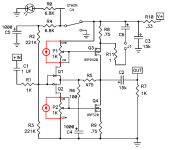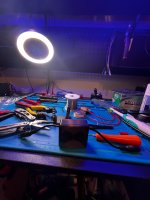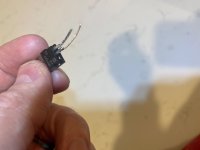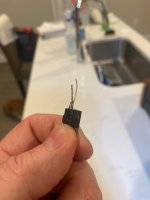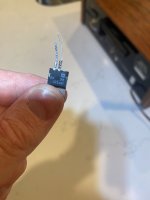Two pins are for the LED. You'll need to add a resistor for the LED if you tap directly into the 24VDC (typical rule of thumb is 1k-ohm for ever volt, then adjust up/down from there for brightness preferance). So you'll need a 24k ohm resistor for "nominal", 18k ohm for "bright", 30k ohm for "dimmer", or anything in between.
Sound Impression
I am using a Fostex 6" driver in a ported box giving an efficiency of 93dB/Watt which is used both near field while sitting at my desk and far field while lying on my bed (my monitor doubles as a TV). I will exclude tubes and focus on my history with solid-state amps here, I have some nice tube amps 300B SE (missing high end with deep base) and 6L6 SE (very nice but has some 60Hz hum). The promise of high-efficiency speakers and their compatibility with low-wattage topologies has always interested me unfortunately for some time the only thing in the solid-state realm that sounded decent was class-d amps. I started with a 10-watt Tripath Sure TA2024 Class-T amp running on a 12v wall brick supply. It had some hiss and a little bit of tube warmth. I tried higher-wattage class-T amps but they lost a bit of magic. Then I moved on to the Texas Instruments TPA3110, another Sure PCB. It has a little less distortion and hiss and a little more power. I tried the original SE ACA amp, it was much quieter than the class-d fair but 'S' sounds at the the back of words were harsh. Full-range speakers can be temperamental like that so the original ACA didn't last long in the system. Then I went on to the TPA3255 which has less hiss and more power running off a 24v laptop brick. Then I tried the ACA mini, it had cleaner high-end than the TPA3255 and virtually zero noise even without a case. When switching from the TPA3255 to the ACA mini the focus shifted away from the midrange and more information was coming from upper frequencies, as I was not used to it I moved back to the TPA3255 for a few days only to realize that the ACA mini was more correct, so the ACA mini went back in. I keep the best amp in the system. My only complaint with the ACA mini vs the TPA3255 is that the ACA mini gets a little shouty at higher volumes, normally higher than I go. Next, I tried a Schiit Rekkr compared to the ACA mini, they are both CFA topologies, and the Rekkr is DC coupled running off + and - 6v rails rated at 2 watts of power class AB. It runs warm but unlike the mini, you can keep your hand on the heatsink. Rekkr sounded similar to ACA mini but with a little less dynamics with a little less base though the Rekkr did seem like it could be turned up loader without distortion. But the ACA mini took the crown and went back in, so it's currently at the top of the heap. The ACA mini max could be the next step up, with the extra bias it would be less shouty at higher volumes, but at $400 it's a bit of a step up from all these sub $100 amps. There is a lot of competition at this price point including Aliexpress clones of Dartzeel NHB-108 and Accuphase A60s but the small footprint of the ACA mini max is nice and convenient. Also the Jean Hiraga "Le Monstre" could be worth a try, with a few mods it could easily be made to run off a mono-rail 24v supply now that Mr. Pass has shown us how to run a CFA off a mono-rail. The ACA mini and the Le Monstre are very similar topologies so it may be interesting to mix and match, for example seeing if bipolar outputs sound better or if a diamond buffer input sounds better. One advantage of a diamond buffer input would be that the bias could be trimmed at the first bipolar stage and the 1K pots could be replaced with fixed resistors this would bring up the open loop gain a little (6dB). The input impedance may need to come down a bit.
And an idea:
This brings to mind another idea, if we place a small CSS (1-3mA) in series with P1 and P2 we can get a little more open loop gain because the pots need to be turned up higher. The CCS needs to work with as little as 3V across it. For example, a ccs diode like E-202, Mouser Part #954-E-202 or if we used a jfet as a ccs we could trim its source resistor and leave P1 and P2 as fixed values. Would it improve the sound, I don't know.
I am using a Fostex 6" driver in a ported box giving an efficiency of 93dB/Watt which is used both near field while sitting at my desk and far field while lying on my bed (my monitor doubles as a TV). I will exclude tubes and focus on my history with solid-state amps here, I have some nice tube amps 300B SE (missing high end with deep base) and 6L6 SE (very nice but has some 60Hz hum). The promise of high-efficiency speakers and their compatibility with low-wattage topologies has always interested me unfortunately for some time the only thing in the solid-state realm that sounded decent was class-d amps. I started with a 10-watt Tripath Sure TA2024 Class-T amp running on a 12v wall brick supply. It had some hiss and a little bit of tube warmth. I tried higher-wattage class-T amps but they lost a bit of magic. Then I moved on to the Texas Instruments TPA3110, another Sure PCB. It has a little less distortion and hiss and a little more power. I tried the original SE ACA amp, it was much quieter than the class-d fair but 'S' sounds at the the back of words were harsh. Full-range speakers can be temperamental like that so the original ACA didn't last long in the system. Then I went on to the TPA3255 which has less hiss and more power running off a 24v laptop brick. Then I tried the ACA mini, it had cleaner high-end than the TPA3255 and virtually zero noise even without a case. When switching from the TPA3255 to the ACA mini the focus shifted away from the midrange and more information was coming from upper frequencies, as I was not used to it I moved back to the TPA3255 for a few days only to realize that the ACA mini was more correct, so the ACA mini went back in. I keep the best amp in the system. My only complaint with the ACA mini vs the TPA3255 is that the ACA mini gets a little shouty at higher volumes, normally higher than I go. Next, I tried a Schiit Rekkr compared to the ACA mini, they are both CFA topologies, and the Rekkr is DC coupled running off + and - 6v rails rated at 2 watts of power class AB. It runs warm but unlike the mini, you can keep your hand on the heatsink. Rekkr sounded similar to ACA mini but with a little less dynamics with a little less base though the Rekkr did seem like it could be turned up loader without distortion. But the ACA mini took the crown and went back in, so it's currently at the top of the heap. The ACA mini max could be the next step up, with the extra bias it would be less shouty at higher volumes, but at $400 it's a bit of a step up from all these sub $100 amps. There is a lot of competition at this price point including Aliexpress clones of Dartzeel NHB-108 and Accuphase A60s but the small footprint of the ACA mini max is nice and convenient. Also the Jean Hiraga "Le Monstre" could be worth a try, with a few mods it could easily be made to run off a mono-rail 24v supply now that Mr. Pass has shown us how to run a CFA off a mono-rail. The ACA mini and the Le Monstre are very similar topologies so it may be interesting to mix and match, for example seeing if bipolar outputs sound better or if a diamond buffer input sounds better. One advantage of a diamond buffer input would be that the bias could be trimmed at the first bipolar stage and the 1K pots could be replaced with fixed resistors this would bring up the open loop gain a little (6dB). The input impedance may need to come down a bit.
And an idea:
This brings to mind another idea, if we place a small CSS (1-3mA) in series with P1 and P2 we can get a little more open loop gain because the pots need to be turned up higher. The CCS needs to work with as little as 3V across it. For example, a ccs diode like E-202, Mouser Part #954-E-202 or if we used a jfet as a ccs we could trim its source resistor and leave P1 and P2 as fixed values. Would it improve the sound, I don't know.
Attachments
It sounds like you enjoy a nice push pull design. 🙂 There are a few that are similar to this ACA Mini.
I tried a constant current source on the JFET stage of a F5m and it altered the character of the sound. I just used resistors though...
-ACA Mini max - Probably a bit more dynamic, less shouty at higher volumes. I have not heard it though.
-F5m - Definitely more dynamic, handles high volume with your efficient speakers a lot better than the ACA Mini. Great imaging. Great highs!
-BA3 - a cool design that is very flexible. The front end is pretty much a F5 without feedback. Output stage is an additional stage.
-Original F5 and F5 turbo. Fantastic designs. More detailed and maybe dryer sounding but some people prefer that.
Then there are other amps with two PP stages that are also pretty similar,
This general F5 type of topology has been used in many designs over the years. If it were me, I would try the F5m. It is a simple design with some neat tricks. The JFETs share the same source resistor, the output stage generates the 2nd harmonic distortion and it is cheap for a larger 25w amp. No gate resistors... Not to mention the chassis (recommend a 4U 300m UMS) can be used for many designs along with the power supply. Just swap amp boards and tune.
I tried a constant current source on the JFET stage of a F5m and it altered the character of the sound. I just used resistors though...
-ACA Mini max - Probably a bit more dynamic, less shouty at higher volumes. I have not heard it though.
-F5m - Definitely more dynamic, handles high volume with your efficient speakers a lot better than the ACA Mini. Great imaging. Great highs!
-BA3 - a cool design that is very flexible. The front end is pretty much a F5 without feedback. Output stage is an additional stage.
-Original F5 and F5 turbo. Fantastic designs. More detailed and maybe dryer sounding but some people prefer that.
Then there are other amps with two PP stages that are also pretty similar,
This general F5 type of topology has been used in many designs over the years. If it were me, I would try the F5m. It is a simple design with some neat tricks. The JFETs share the same source resistor, the output stage generates the 2nd harmonic distortion and it is cheap for a larger 25w amp. No gate resistors... Not to mention the chassis (recommend a 4U 300m UMS) can be used for many designs along with the power supply. Just swap amp boards and tune.
Just need to clarify. I set of resistors does not match the image on digikey. I’m assuming these are R3 because they are the only one not matching and they seem to read 220k (I need to get a better LCR meter).
https://www.digikey.com/en/products...oric-bc-components/SFR2500002203JA500/5065450

https://www.digikey.com/en/products...oric-bc-components/SFR2500002203JA500/5065450
From your Digi-Key link.Just need to clarify. I set of resistors does not match the image on digikey. I’m assuming these are R3 because they are the only one not matching and they seem to read 220k (I need to get a better LCR meter).
https://www.digikey.com/en/products...oric-bc-components/SFR2500002203JA500/5065450
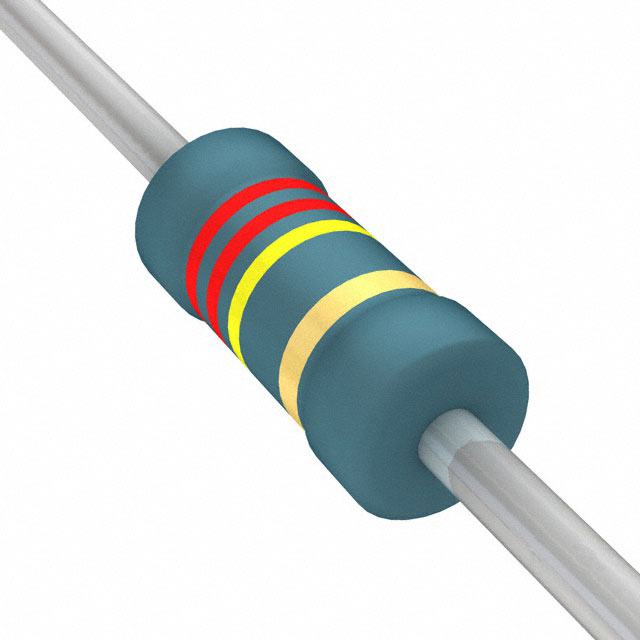
Image shown is a representation only. Exact specifications should be obtained from the product data sheet.
Emphasis added is mine.
Trust your DMM and double-check the bands. Here is a link (also Digi-Key) to an easy-to-use resistor band decoder.
Handy Decoder
I've forgot the mnemonic by Pops taught me long time ago. I carry around a little color code chart I got off the back of a Rat Shack resistor pack. Wikipedia has a few good mnemonics:
https://en.wikipedia.org/wiki/Electronic_color_code
https://en.wikipedia.org/wiki/Electronic_color_code
I broke one of my IRF520 MOSFET’s. 🙁
Can someone link me a correct replacement. I see more than one with that part number
Can someone link me a correct replacement. I see more than one with that part number
Oh, that Violet....I see they avoided the most popular mnemonic.....

I have an odd feeling that's the one my Pops taught me.I see they avoided the most popular mnemonic.....

I’m now seeing how they include matched pairs in the kit. Did I screw this up badly? I broke it while desoldering since I installed it in the wrong side…I really hope I don’t have to do that again. I could possibly try and repair the broken lead using a piece of a trimmed resistor lead.I broke one of my IRF520 MOSFET’s. 🙁
Can someone link me a correct replacement. I see more than one with that part number
Post a good resolution up close picture @ross51681
The experts will tell you what's the best path forward. You may be able to use one of the 3W resistor leads you cut off to bridge the broken lead to the thru hold in my humble opinion.
The experts will tell you what's the best path forward. You may be able to use one of the 3W resistor leads you cut off to bridge the broken lead to the thru hold in my humble opinion.
Last edited:
- Home
- Amplifiers
- Pass Labs
- DIY ACA mini
